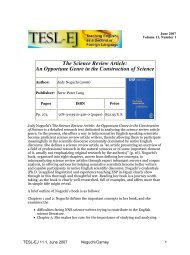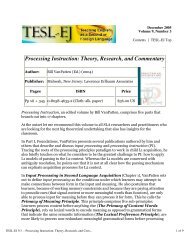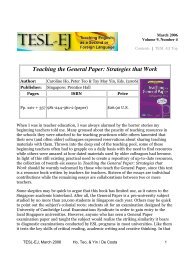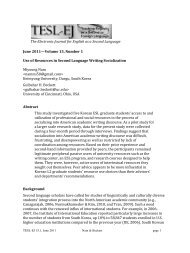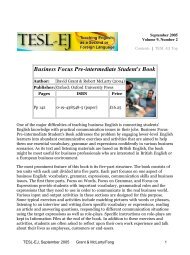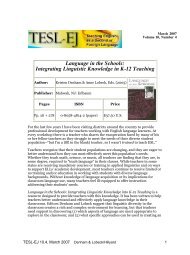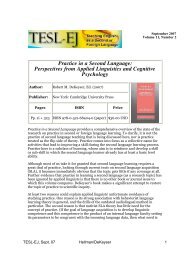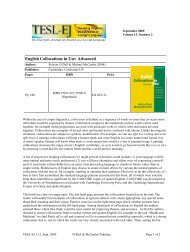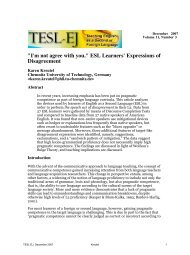Volume 14, Number 3 Activating the Desire to Learn Aut - TESL-EJ
Volume 14, Number 3 Activating the Desire to Learn Aut - TESL-EJ
Volume 14, Number 3 Activating the Desire to Learn Aut - TESL-EJ
You also want an ePaper? Increase the reach of your titles
YUMPU automatically turns print PDFs into web optimized ePapers that Google loves.
The Electronic Journal for English as a Second Language<br />
December 2010 – <strong>Volume</strong> <strong>14</strong>, <strong>Number</strong> 3<br />
<strong>Aut</strong>hor: Bob Sullo (2007)<br />
<strong>Activating</strong> <strong>the</strong> <strong>Desire</strong> <strong>to</strong> <strong>Learn</strong><br />
Association for Supervision and Curriculum Development,<br />
Publisher:<br />
Alexandria, Virginia<br />
Pages ISBN Price<br />
164 pages 978-1-4166-0423-5 $23.95 U.S.<br />
In <strong>Activating</strong> <strong>the</strong> <strong>Desire</strong> <strong>to</strong> <strong>Learn</strong>, Bob Sullo, a veteran K-12 U.S. public school teacher,<br />
shares his insight on student motivation in <strong>the</strong> classroom and how our internal needs driven<br />
our motivation <strong>to</strong> learn. These include, he argues <strong>the</strong> needs: <strong>to</strong> connect, be competent, make<br />
choices, have fun, and be safe. The better <strong>the</strong>se needs are fulfilled, he argues, <strong>the</strong> better<br />
student behavior and achievement. In o<strong>the</strong>r words, he explains, “We are motivated from <strong>the</strong><br />
inside out.” This Written as a series of conversations between Sullo and his past and present<br />
K-12 students, teachers, and colleagues, <strong>Activating</strong> <strong>the</strong> <strong>Desire</strong> <strong>to</strong> <strong>Learn</strong> is a grounded<br />
overview of <strong>the</strong> research on motivation, case studies of strategies, suggestions on assessing<br />
student performance, and concrete guidelines for incorporating motivation strategies in<strong>to</strong><br />
everyday classroom practice.<br />
<strong>Activating</strong> <strong>the</strong> <strong>Desire</strong> <strong>to</strong> <strong>Learn</strong> is organized in<strong>to</strong> four parts: Part I addresses <strong>the</strong> <strong>the</strong>ory and<br />
research behind motivation and <strong>the</strong> evidence for it and <strong>the</strong> remainder of <strong>the</strong> book is an<br />
application of <strong>the</strong> research in each school level (Part II addresses Elementary School, Part III<br />
Middle School, and Part IV high school). The main focal points of <strong>the</strong> book that are addressed<br />
through its entirety include <strong>the</strong> nature of motivation and its relationship <strong>to</strong> leaders,<br />
productivity, and collaboration. A high school educa<strong>to</strong>r, I still found it helpful <strong>to</strong> read <strong>the</strong><br />
o<strong>the</strong>r parts of <strong>the</strong> book on elementary and middle education, even though I was hesitant of its<br />
relative-ness and usefulness.<br />
Defining <strong>the</strong> nature of motivation, Sullo first explains <strong>the</strong> idea of a “need-satisfying”<br />
classroom and how that relates <strong>to</strong> classroom behavior. Just like relationships, positive<br />
classrooms tend <strong>to</strong> resolve upsets and disruptions faster than a negative classroom. A positive<br />
<strong>TESL</strong>-<strong>EJ</strong> <strong>14</strong>.3, December 2010 Sullo/Holshouser Page 1 of 2
classroom setting is need-satisfying and <strong>the</strong> students feel a sense of belonging, power or<br />
competence, freedom, and have fun. There is a sense of mutual respect between <strong>the</strong> teacher<br />
and student. Sullo gives <strong>the</strong> advice that teachers should structure <strong>the</strong>ir classrooms that satisfy<br />
<strong>the</strong>se basic needs by doing what <strong>the</strong> teacher wants and not ano<strong>the</strong>r behavior, which minimizes<br />
disruptions and problems.<br />
<strong>Activating</strong> <strong>the</strong> <strong>Desire</strong> <strong>to</strong> <strong>Learn</strong> reads as a compelling s<strong>to</strong>ry (or series of s<strong>to</strong>ries) that is full of<br />
practical classroom advice, evidence, applications of <strong>the</strong> research, and strategies for<br />
implementing suggested ideas. It would be a valuable book for any educa<strong>to</strong>r, including<br />
language educa<strong>to</strong>rs, <strong>to</strong> read as <strong>the</strong> information presented applies <strong>to</strong> a diversity of educa<strong>to</strong>rs<br />
and people working in education (non-teachers) in a variety of grade levels. All teachers can<br />
benefit by reading Sullo’s book because <strong>the</strong> desire <strong>to</strong> learn and motivation are issues every<br />
educa<strong>to</strong>r faces.<br />
When I started reading this book, I found <strong>the</strong> research and <strong>the</strong> evidence interesting, but not<br />
very compelling until I reached Sullo’s applications and strategies. I was sucked in<strong>to</strong> intense<br />
discussions between educa<strong>to</strong>rs that I could relate <strong>to</strong>—and it made me think about my own<br />
practice. Reading, I reflected as a teacher on <strong>the</strong> motivation of my students and tried <strong>to</strong><br />
discern why certain students are not motivated <strong>to</strong> learn in my class and how I might<br />
restructure my classroom so that <strong>the</strong>y might be.<br />
Regardless of <strong>the</strong> grade level taught, <strong>the</strong> information presented is of general usefulness <strong>to</strong> all<br />
educa<strong>to</strong>rs and non-educa<strong>to</strong>rs alike. Even though I was personally inspired reading about<br />
empowering teachings taking on motivation in <strong>the</strong>ir classrooms, I sometimes wonder if <strong>the</strong><br />
motivation is beyond <strong>the</strong> purview of a classroom teacher. There are specific changes I could<br />
make in my classroom—but <strong>the</strong> teachers, administra<strong>to</strong>rs, and o<strong>the</strong>r school staff need <strong>to</strong> be on<br />
board with <strong>the</strong> change in order for it <strong>to</strong> truly be effective. On a smaller scale, Sullo’s strategies<br />
can be applied <strong>to</strong> one classroom at a time—and I guess that’s a starting point even if an<br />
inadequate one.<br />
Reviewed by<br />
Karen Holshouser<br />
Bartlett Yancey High School (Caswell County Schools)<br />
North Carolina USA<br />
<br />
Copyright © 1994 - 2010 <strong>TESL</strong>-<strong>EJ</strong>, ISSN 1072-4303<br />
Copyright rests with <strong>the</strong> authors.<br />
<strong>TESL</strong>-<strong>EJ</strong> <strong>14</strong>.3, December 2010 Sullo/Holshouser Page 2 of 2



